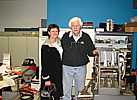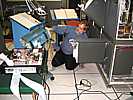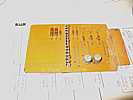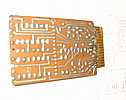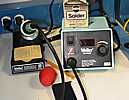Schedule March 2006
return to main 1401 Restoration Page
go to April 2006
go to Team Bios
Contents:
Wednesday March 1st
Saturday March 4st
Wednesday March 8th
Saturday March 11th
Wednesday March 15th
Wednesday March 22th
Saturday March 25th
Wednesday March 29th
- Wednesday March 1st - 10 AM - Roll up sleeves -
- Present were: Frank King, Bob Erickson, Grant Saviers, Bob Feretich, Ron Williams, Ron Crane, Chuck Kantmann, Bill Flora, Glenn Lea, Don Luke, Jeff Stutzman, Robert Garner, and Ed Thelen.
- Lots of folks - almost too many for the single 1401 and the many current projects.
- 1401 instructions - such as multiply/divide ...
- 1401 instruction overlap and reliability of 1402 card reader
- 1401 and 1402 card punch
- 1401 TAU (Tape Adaptor Unit)
almost like too many cooks sharing one burner in the kitchen
Three guys left at noon on a non 1401 mission.Ron Williams came in Tuesday Feb 28th. Bob Feretich, Ron Crane, Jeff Stutzman are coming in this Saturday March 4th - about 10:00.

OldEyes, BadPrintsRon Williams and Bill Flora worked some on instruction overlap until about 3:00 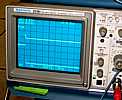
Bob Feretich and Ron Crane worked on debugging the 1401 TAU (Tape Adaptor Unit) until about 6:30
They spent the day debugging the TAU RESET switch and logic (even the switch was bad!!) Here is more detailed report- Robert Garner and Ron Crane examined good and bad transistors with his 7CT1N transitor curve tracer module. Ron Crane thinks the strange loops are caused by - hope I have this correct - secondary breakdown and current crowding - this heats small parts of the base region and causes local heating, increased beta (current gain) in the hot spots - thermal runaway prevented only by the load resistors. He was able to show that even new production transistors did this - to a much reduced extent. See this report
- A transistor report - some SMS card types are used only in the TAU. The general family is DGx, where x can be V,W,X,Y,Z.
See 1401 Unit Plugging Chart and
1401 Unit Plugging Sorted By SMS
These cards use a different transistor than we have seen before - the IBM type 117. This is not listed in the
substitution web page
- Ron Crane identified them a PNP type. 2N1303 transistors were used in their place,
and seemed to work well - Bob Feretich noted that they caused much closer "rail to rail" voltage swings than
the original type 117s, and were faster as well. The following report is from Bob Feretich:
- First note that these observations are based solely on yesterday's debug session. Previous TAU debug sessions focused on more complex SMS cards (counter triggers and oscillators). These cards are the same as those used in the CPU and showed no extraordinary characteristics.
- A guess of failure density for type 117 transistors in TAU logic is 10%. That is, it seemed that in the logic we were stimulating, one in every ten transistors was bad.
- The most common problem found was leakage. The transistors would not turn off. This accounted for a three of the five transistor problems we found yesterday.
- The other two failures were leads that corroded through. The type 117 transistors have very fine leads. The leads on the failed units separated from the transistor case. I believe that at least one of these failures was caused by card inspection. We probably broke the lead while inspecting the card and we were not handling it roughly. I suspect that we have a large number of transistors with very fragile leads. Perhaps even already broken, but physically touching and therefore conducting.
- The Type 117 transistor is not in our substitution charts, so Ron Crane replaced them with generic Germanium PNPs (I don't remember the part number). The replacements seem to be working, but we are testing reset circuitry in halted mode.

2N1300
2N1301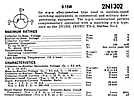
2N1302
2N1303
2N1304
2N1305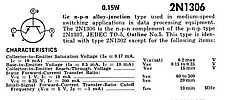
2N1306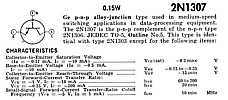
2N1307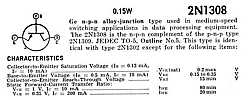
2N1308

Bob Feretich also plugged in the almost complete TAU-Checker/Tape-Unit-Emulation box and checked some functions. Note the ribbon cables connecting to the 1401 Tape Cable Plug. 
We are looking for *new recruits* interested in learning about *REAL OLD* computers. I think my grandson - Mason Thelen - is a likely prospect. 
There has been *NO RESPONSE* - other than by Van Snyder - to Ron Williams' print a powers of 2 chart. A help might be Ron Mak's ROPE.
- Saturday March 4th - 10 AM - A "bonus day" for the hearty or stubborn -
Report by Chuck Kantmann:
Present Ron Williams, Bob Erickson and Chuck Kantmann - Found bad memory [sense amp] card for 1401 lower 4K (not 1406). Visible storage machine cards are different but do match the 1406 memory cards. Replaced an 083 transistor on card.
- Setup program to shoot overlap but but the 1402 was not feeding cards and receiving validity checks and jamming with blank cards. Removed pinch shaft for feed rollers. The material on the rollers for both shafts had flat spots. Found 1 missing screw and 1 loose.
- Need to check 1402 in visible storage for good rollers or fab new ones.
- Told several tall tales.
Back Wednesday.1401 has overlap bug and multply bug to shoot.
xoxox
Chuck
- Wednesday March 8th - 10 AM - Roll up sleeves -
- Present were: Grant Saviers, Robert Garner, Bob Feretich, Bill Flora, Glen Lea, Ron Williams, Bob Erickson, Ron Crane and Ed Thelen
- Ron Williams found another bad card in instruction processing. John Van Gardner points to
his experiences
with instruction overlap. Other Van Gardner stories
Apparently, a big cut over in 1401 processors relative to Instruction Overlap was #25,000.
According to Robert Garner, our German 1401 is serial number is #28,421 and the
other (English) one the museum has is #20,597.
There has been quite an e-mail dialog between Paul Pierce (Oregon), John Van Gardner (Georgia), and Robert Garner (California) about the different versions of 1401s. Here is a fragment:
According to Paul Pierce, there was a major rev between these two. Paul is correct. There was a cleanup repackaging at 20000. If you look at the Maint. manual 225_6487-3 in the service aids there are many references to the above 20000 machines. At 25000 there was a major repackage that installed a lot of edge connector blocks on the center frame member to make it easier to install changes and make room for the Process overlap feature.
One other thing I remembered about the TAU-2 to TAU-9 change. They came out with the 7330 tape drive and you had to have a TAU-9 to use them. It would work with 729s or both if you had the feature.
btw, had you heard how many 1401's were delivered to customers?
The set I've heard is {10k, 15k, 20k}.I remember when they passed 13k but did not hear after that. I went to Poughkeepsie in the fall of 1964 to work on the 360/50 until the fall of 1965 and was out of the 1401 business after that.
Van
- "We" received permission and did swap a roller with the Visible Storage 1402 Card Reader/Punch.
There was so much other activity on the 1401 that there was no time to test the effect.
(You don't think I'm going to photograph incriminating evidence do you?)
- Bob Erickson and Glen Lea got the 077 collator to do pocket selection to work on three of the four pockets.
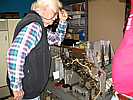
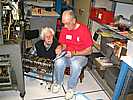
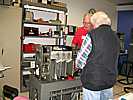
If Bob keeps pulling his hair - he will get bald like me :-((
This machine is not wired like that - let's change it back
HEY - Look at that - we can select to three pockets :-))

Grant Saviers brought in power supplies, signal sources, a "third hand" and a binocular microscope for a proposed improved card test station 
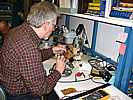
Grant Saviers and others discussed card storage and card testing and software to support card history and location. Grant thinks he has located a Stanley Vidmar cabinet with drawers suitable for storing all of "our" spare cards :-)) - Bob Erickson and Glen Lea got the 077 collator to do pocket selection to work on three of the four pockets.
- Saturday March 11th - 10 AM - Roll up sleeves -
- Present were:
Ron Mak, Ron Crane, Ron Williams, Bob Feretich, Bob Erickson, Robert Garner,
and the rest of us with non-standard names- Tim Coslet and Ed Thelen ;-)) - At the risk of having non-period service equipment in the 1041 Restoration Room ;-))
- We were warned in advance that a Journalist from Wired magazine was going to show up
to observe this month's CHM Volunteer Saturday.
Imagining spotlights, massive video cameras and cables, directors and producers hovering about, and other romantic notions ... we awaited with eager anticipation for our instant fame and possible fortune (speaking for myself of course).I rehearsed my spiel of "blinding electronic speed", "all transistor", "solid state reliability", "16,000 character core memory", "hardware multiply and divide option", "11 microsecond memory access time", ... all the latest techie talk.
I imagine the others were similarly prepping and primping -
One guy even looked showered !! - The Journalist seemed to be two people -
- Matt Rand as old and grizzled as the rest of us - whose eyes twinkled at my techie talkie
I didn't dare hit him up to volunteer to help us -
- The other a pleasant young whippersnapper with note pad and pocket camera
- I think this real old stuff was all new to him ;-))
- [ It turns out that this "journalist" was CHM's Director of Marketing, Bob Stetson! ] - But the hit of our show seemed to be Bob Erickson with his electromechanical 077 collator!.
Imagine! not a transistor in that old oily noisy thing with belts and cams and shafts wherring!!
I mean - the thing has moving parts and is as ancient as Bob himself :-((
It doesn't even have blinking lights !! :-(((
Not that I am jealous :-((((
;-)) - Ron Mak came by and gave the Journalists a demo of his packaging of a 1401 simulator,
the AutoCoder assembler, into his really neat ROPE (Ron's Own Programming Environment).
It provides:
- a view of the input deck,
- the generated Autocoder listing (with setable break points)
- a simulated view of the console with lights correctly simulated
- a simulated view of the printed output
- and neat simulation controls and setable breakpoints
Ron says we are already getting "D"s for late homework :-(( - Van Snyder has recently found the bug in the 1401 FORTRAN run time floating point subroutines, and Ron Mak may,
with popular demand ;-) package the FORTRAN compiler, ... into a Graphical Programming Environment.
Wouldn't that be a kick!!
Just for inspiration, here is the Fortran II Reference Manual (5 MegaBytes) and IBM 1401 Fortran Specifications and Operating Procedures (4.8 MBytes) on Al Kossow's web site. You can specify up to 20 decimal digits of precision ;-)) - Ron Crane and Tim Coslet just about cleaned up the backlog of bad boards
- I added a column to list of card names vs card logics to show availability of schematics of the card names - and there are many cards we don't have drawings for - Tim Coslet says that often the difference is load resistors present or not - and reasonably easy to fake.
- Randy Neff scanned some more cards to make reverse engineering them much easier.
- Ron Williams and Bob Feretich pressed on with debugging instruction overlap logic, while trying to keep many the guests ammused by running the 1402 card reader at 800 cards/minute (13/second) and the printer at 600 lines/minute printing powers of 2
- Wednesday March 15th - 10 AM - Roll up sleeves -
- Robert Garner says that Ron Williams, Bob Erickson, Glenn Lea, Bob Feretich, Grant Saviers,
Bill Flora, Ron Crane and himself were there. I was absent *with* leave.
Tuesday I had the scar tissue causing a "macular pucker" of my right eye's retina peeled off, and also the lens replaced. Even with swollen red eye, tears and all, that eye can see the big "E" on the top of the eye chart better now :-))) And straight lines don't look wiggly. Thank you. Thank you. 
Bill Flora identified a strange plug on the 1401 as a connector to a 1407 Inquiry Terminal.
John Van Gardner was curious :-))- Ron Williams and Bill Flora continued to look for the bug in the Overlap feature, finding one bad SMS card.
- Bob Erikson was able to adjust the 077 Collator (restored with its new/swapped components from the Museum's other 077) to drop cards into all four pockets.
- Bob Feretich found a few more failed/leaky Ge diffused-junction transistors (type 102 this time) on several of the TAU-9 SMS cards.
- Grant Saviers brought in a large quantity of spare 2N1304 and 2N1309 transistors. Checked a sampling of parts on the transistor curve tracer.
Addendum to March 15th
and also -
1401 Core Stack & Switch Cores
TAU Cable to 1401
TAU Tester LEDs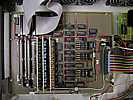
TAU board 1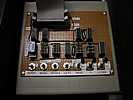
TAU-board 2
- Wednesday March 22nd - 10 AM - Roll up sleeves -
First, a statement of a current sticking point - dated March 20, 2006.
Leroy, I'm sure you are aware by now that we are attempting to restore a 1401 system. We have run into a problem that, so far we have not been able to solve. We believe that the OVERLAP feature that is installed on the machine is the root of the problem. None of us who are working on this problem can remember of having worked on a machine with the overlap feature.
The problem occurs on a read operation. If we code a read, followed by a move from the read input area to the print area, followed by a print, followed by a branch back to the read instruction, that code will execute fine in I/EX mode. The problem is if you run this code sequence in run mode, it fails because the move instruction that moves the data from the input area to the print area is being allowed to execute before the read operation has completed. We can see that the machine is taking overlap cycles between the card rows. It is our understanding that we should not be taking overlap cycles if we have not issued a set overlap instruction.
Have you worked on a machine with the overlap feature? If you remember, can you tell us if we are correct about the fact that we should not be executing overlap cycles if we have not set overlap on. We have scoped this with a memory scope, and can see that we take overlap cycles after each read scan.
Trying to determine why the overlap is occurring, becomes a problem, because it's hard to tell if what we see is a cause of the problem or an effect of some other condition. Any hint you can give about how best to approach a problem of this type would be greatly appreciated.
Thanks in advance for any help you can provide.
Bill Flora - billflora at comcast dot net
I (Ed Thelen) have sniped the Process Overlap Special Feature 1.1 megabytes
out of the larger IBM 1401 Special Feature Instructions 6 megabytes
for emphasis and easier access
- Present were Don Cull, Ron Williams, Grant Saviers, Robert Garner, Bob Feretich, Frank King, Chuch Kantmann, Ed Thelen, Ron Crane, Jeff Stutzman, Glenn Lea, Randy Neff, Brian Yee.
- Don Cull brought in a large box of IBM PC software. What to do - Jim Somers brought some forms for Don to fill out. I guess the CHM acquisitions committee will have to determine if the museum wishes to accept them. (A tough job - only so much room
- Ron Williams and Don Cull continued struggling with the Overlap Feature .
- Randy Neff is continuing to take pictures of the 120 or so SMS cards and overlaying the front and back images to aid documentation and (in some cases) reverse engineering. He is also interested in scanning 1401 ALDs for sharing and digital archiving.
- Grant Saviers is bringing in a 11x17 scanner so that Randy can work scanning daytimes (the museum is now reserving its scanner 8-5). Grant is also bringing in a lap top for long term use in the 1401 room. He and Randy are discussing ideas on an SMS card testor that does not require much skill.
- At lunch we discussed the increasing need for 1401 CPU time - Bob Feretich and Jeff Stutzman will come in on Thursdays to do their thing, and Ron Williams will come in with Bill Flora Wednesdays with the main group.
- Brian Yee, who had been in e-mail contact with Robert Garner, came in and I gave him the "back stage" tour. Brian works near by and starts his day job at noon.
- Robert Garner is going to Turkey to (hopefully) view a total solar eclipse next Wednesday. He and his wife will then spend a few days in Paris. We gave him the assignment of finding Allen Palmer in Paris and talking him into coming back home to work with the 729 tapes ;-))
- Dave Dial is moving stores out of the room adjacent to the 1401 room so that we can spread supplies, work benches, storage cabinets, ... in the "CE" room - We are all too willing to help him knock a doorway through the wall. Dave says that a vent fixture has arrived to help with air flow and fire blocking.
- Ron Crane continued using the curve tracer (see March 8th) to find more bad components on suspect cards. That is a *really* useful tool in skilled hands
go to Team Bios, go to Sched April 2006
